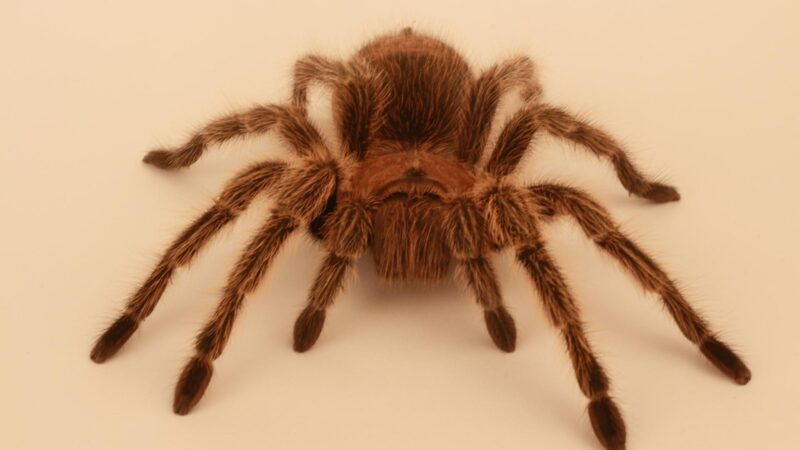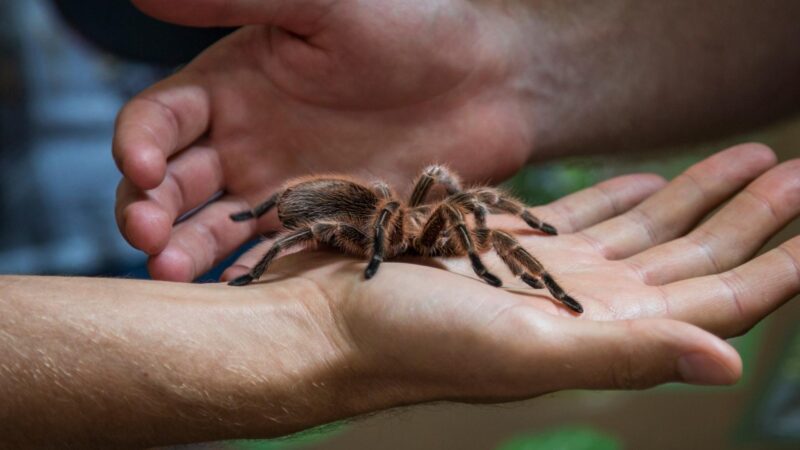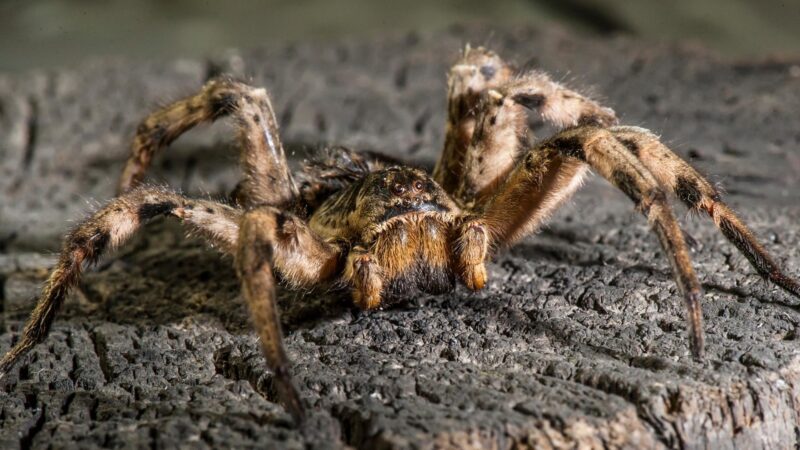Tarantulas are notoriously feared for their creepy-looking hairy bodies, mouths and jaws, large abdomens, and their venomous abilities. Although, they’re virtually harmless to humans.
An interesting fact about tarantulas is that they have multiple eyes but have pretty bad eyesight. Generally, most spider species can have as many as 8 eyes while others have no eyes at all.
All tarantulas have 8 eyes that are small and grouped in pairs located on the top of their cephalothorax. Due to their poor vision, they use vibrations and their sense of touch to navigate, detect motion, and survive in the wild.
Table of Contents
Where Are Tarantula Eyes Located?

Tarantula eyes are located on the cephalothorax, a combination of the head and thorax. They are directly on top of the chelicerae or the mouthparts of the spider.
Most tarantulas, like the Mexican red-knee tarantula, have two large eyes situated in the middle of their heads and three eyes on the left and right sides, for a total of 8 eyes.
Some species have slightly different arrangements, such as the Brazilian red birdeater, which has two rows consisting of four eyes each.
What Is the Anatomy of a Tarantula?
Body
Containing the brain, chelicerae, pedipalps (second appendages), and legs, the cephalothorax is the first of two main body parts of a tarantula. It is also called prosoma.
The abdomen, also called the opisthosoma, is the second main body part. It consists of the tarantula’s internal organs, which include its respiratory, digestive, and reproductive organs. Both body parts are connected by a narrow stalk, referred to as the pedicel.
Located at the far end of the abdomen are the spinnerets or the pores where silk comes out of the spider.
Some scientists claim that certain species of tarantulas have spigots that allow them to shoot silk out of their feet, but were refuted by a 2013 study.
Chelicerae
Referring to the spider’s jaws, which contain its fangs and venom glands, this part is used to trap prey and inject them with venom. They’re located on the front of the cephalothorax.
Behind the chelicerae are mouthparts that are involved in the mashing, manipulation, and consumption of food.
Pedipalps
These leg-like features are found next to the chelicerae and are used for sensation, web shaping, and aid in capturing prey and feeding. Male spiders will have larger pedipalps that are used to transfer sperm to female spiders.
Legs
All tarantulas have 8 legs that are set together in 4 pairs of 2 legs each. Each leg has 7 segments.
Hunting tarantula species have 2 claws attached to them, while species that are proficient in web-building have 3 claws. Some tarantulas may have a third undeveloped claw.
Eyes
Tarantula eyes are described based on their rows, either anterior (A) or posterior (P). The eye position in the row is determined by either lateral (L) or medial (M).
The two large eyes that are situated in the middle are the primary eyes which are also called Anterior Medial eyes (AME), while the secondary eyes are the Posterior Lateral Eyes (PLE), Anterior Lateral Eyes (ALE), and Posterior Medial Eyes (PME).
The secondary eyes are immobile and are used to detect motion, add depth to the spider’s perception, and help locate prey. They also allow spiders to have a wide range of vision.
Are Tarantulas Blind?

Tarantulas are not blind, but they do have poor eyesight that’s mostly blurry. They can see light and darkness, but that’s about it.
Despite not being able to see—or hear for that matter since tarantulas don’t have hearing organs—they can sense the world through touch, vibrations, and proprioceptor stimuli felt by their hairs and legs.
They can pick up the motion of both potential predators and prey and can recognize their position in space.
What Colors Do Spiders See?
Past research evidence shows that jumping spiders can only see colors in the ultraviolet and green wavelengths. However, some scientists think that they have true visions and can see a variety of high-definition colors even better than humans.
Tarantulas, in particular, were always assumed to be color-blind. But a study suggests that they can perceive the blue colors of other tarantulas and that some arboreal species can perceive green colors.
What Color Do Spiders Hate?

Light blue is known to repel spiders and stops them from building webs, whereas green attracts them. This is why pest control agencies recommend painting walls and interiors with light blue shades to prevent the appearance of spiders.
Are Spiders Afraid of Light?
Most spiders are bothered by the light. However, they usually weave their webs near a light source or reflective surfaces since those areas can attract their prey.
Spiders are more commonly found in dark, moist places that are usually quiet and free from external interferences with humans.
There are some species, such as wolf spiders, that prefer open fields, meadows, gardens, and lawns, depending on their preferred food source. Tarantulas like desert and grassland areas with dry soils.
Do Pet Tarantulas Recognize Their Owners With Their Eyes?

Pet tarantulas don’t recognize their owners with their eyes. Tarantulas have cognitive abilities and may develop distinctive behavioral patterns, but they don’t include remembering their owners.
With that said, tarantulas can’t be tamed and have shown aggressive behaviors even if they were reared in captivity. Therefore, they don’t care who handles them, owners, or not, since they won’t remember.
They can, however, use whatever little there is of their memory-retaining skills to remember web shapes and structures.
Can Spiders See You Looking at Them?
Spiders can’t see you looking at them. They can detect your presence and movement but won’t be able to form an image of you since they have blurry visions and some species have limited color ranges.
Jumping spiders, however, have better vision than most spiders which helps them see in better detail, although there is no scientific evidence yet to prove that they can see humans looking at them.
Why Do Tarantulas Have 8 Eyes?

Tarantulas have 8 eyes for survival reasons. They aren’t equipped with necks that allow animals with more range of motion with their heads, and they also don’t have audio receptors that can help them hear sounds.
Having 8 eyes, accompanied by their legs and hairs, will rectify this situation by providing them with a wide, virtually 360° range of vision that aids in detecting motion and light, locating prey and predators, and gaining a sense of position and space.
What Kind of Eyes Do Tarantulas Have?
Unlike most insects that have compound eyes, tarantulas have simple light-sensitive eyes that don’t have multiple lenses. Instead, they have one lens for each eye and retinas that vary in light sensitivity. They don’t have irises as humans do, so they angle their heads when focusing.
Can You Identify Spiders Based on Their Eyes?

You can identify spiders based on their eyes. In fact, one of the methods experts use to categorize families of spiders is based on the number and position of their eyes.
Frequently Asked Questions
Do Any Spiders Have 12 Eyes?
Spiders don’t have 12 eyes. The maximum amount of eyes that spiders have is 8.
Can Spiders Have 10 Eyes?
Spiders can’t have 10 eyes. They have either 2 to 8 eyes or none at all.
Do All Spiders Have 8 Eyes?
Most spider species have a maximum of 8 eyes or no eyes at all. All tarantulas, jumping spiders, and black widows are known to have 8 eyes.
What Spiders Have 6 Eyes?
There are certain spider families that have 6 eyes which include the Sicariidae family (recluse spiders and sand spiders), Scytodidae family (spitting spiders), Oonopidae (goblin spiders), Tetrablemmidae (armored spiders), and Segestriidae (tube-dwelling spiders).
Are There Spiders With No Eyes?
There are spiders with no eyes. A scientist discovered the Sinopoda scurion, a huntsman spider with no eyes. They live in caves and have biologically adapted to their environments, which have no light. Hence, they don’t grow eyes.
Tarantulas have 8 eyes that aid them in their survival and may slightly vary in position depending on the species, but most will have two primary eyes in the middle and secondary eyes at the sides of their heads.
They have poor eyesight. Therefore, they depend on their keen sense of touch and vibrations. They can perceive blue colors and green colors, depending on the species.
List of Sources
Giesler, A., Zaitz, D. (2011).Brachypelma Smithi. Animal Diversity Web.
Kazilek, C., Cooper, K. (2009). How Do You Know If an Animal Can See Color? ASU – Ask A Biologist.
Zurek, D. B., et al. (2015). Spectral Filtering Enables Trichromatic Vision in Colorful Jumping Spiders. Current Biology.
Foley, S., Saranathan, V., Piel, W. H. (2020). The Evolution of Coloration and Opsins in Tarantulas. The Royal Society Publishing.
Tarantulas: Terrible or Terrific! Cornell University.
